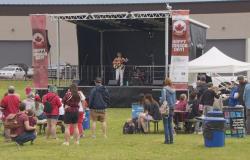A chalet with views of the popular ski resort of Verbier.Image: iStockphoto
A new UBS survey shows how the holiday apartment market is developing in Switzerland — and how prices continue to soar.
Niklaus Vontobel / ch media
Verbier (VS) is now the most expensive tourist destination in the Alpine region. This is what the major bank UBS writes in its study on the market for Alpine second homes. For secondary housing in the high-end market, you have to pay at least 21,500 francs per square meter. This is about 10% more than last year.
If it seems expensive to you, that’s because it is. However, this is only the high-end market, which is different from the so-called “luxury” market, where the rich and super-rich find themselves. In Verbier, you will have to pay double for luxury accommodation, or around 43,000 francs per square meter.
Engadine/St. Moritz in the canton of Graubünden, which until now held first place, comes in second place. Prices per square meter there fell by 1% compared to the previous year. The difference in Verbier is however minimal, with only 300 francs less.
And when it comes to luxury real estate, St. Moritz is still number one, with a price per square meter of 42,000 francs. St. Moritz can therefore continue to boast of being the “meeting place of the aristocratic and international upper class”, which practically founded winter tourism with its own hands 150 years ago.
Andermatt get the ball rolling
Zermatt came out on top, with an increase of almost 5% compared to the previous year. The square meter now costs almost 20,000 francs – just barely, but not much more, than Gstaad in the canton of Bern. Gstaad need not fear for its status either, because among luxury destinations, the upscale resort in the Bernese Oberland is ranked second in Switzerland by UBS.
So it was probably a bit of an exaggeration when a former sports star complained in the tabloid media that Gstaad had lost its luster. Real stars like Princess Diana or Liz Taylor would have been replaced by ill-mannered nouveau riche, whose Ferrari roar would no longer be bearable.
Just behind these historic big names, in the high-end market, is Andermatt, in the canton of Uri, where Egyptian investor Samih Sawiris began construction of a resort in 2009. By 2022, the largest operator of ski areas in the world, the American investor Vail Resorts has also invested there. Among the most expensive luxury Alpine destinations, Andermatt already occupies 4th place.
The boom, after that?
Considering all destinations, prices in the first quarter of 2024 were on average almost 4% higher than the previous year. This certainly represents a significant increase, but it also indicates a slowing of the boom. Indeed, in the previous two years, price increases were each more than 6%. Since the end of 2019, second homes have increased by an average of 30%, significantly more than residential real estate as a whole.
This boom is expected to end this year. UBS predicts stagnation, prices should therefore no longer increase. Thus, second homes will again fall behind other residential real estate, which, according to UBS, will continue to increase this year.
These prices reflect long-term trends. Before the Covid-19 pandemic, the second home market was still under poor auspices, writes UBS. Prices stagnated and a notable number of homes were for sale.
At the time, second homes still seemed old-fashioned. Cheap airfares made short trips around the world affordable and attractive. In comparison, owning a home in the Alps seemed like a constraint, according to UBS. Then the pandemic arrived with its travel restrictions.
Vacations in the Alps suddenly became the only option — and therefore fashionable again. Surprisingly, they remained so even after travel restrictions were lifted. As recently as 2023, during peak periods, most hotels in popular destinations were virtually full, although room prices were much higher.
Distance attracts
In this context, the demand for second homes has also increased. They are the most attractive way to enjoy a few days in the Alps without the stress of booking. But according to UBS, this trend is unlikely to continue. More and more people are being drawn back to distant destinations, as evidenced, for example, by the attendance figures at Zurich and Geneva airports, which have practically returned to their pre-pandemic levels. Added to this are higher interest rates, which are dampening demand.
Since second homes are a luxury product, they are more easily discounted than primary residences. Demand therefore decreases. However, the supply of second homes is limited. Ultimately, this means prices will stagnate this year — and so the boom is on hold for now.
Translated and adapted by Noëline Flippe






